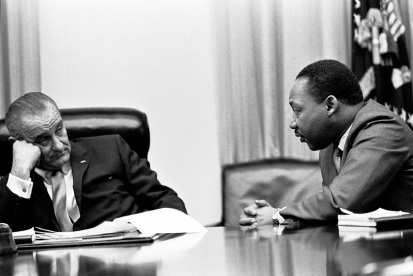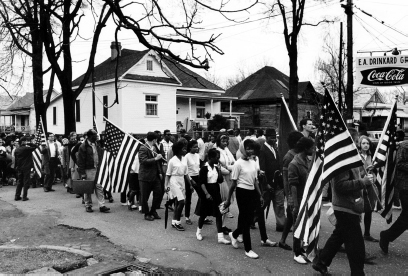The Black History of the White House (35 page)
Read The Black History of the White House Online
Authors: Clarence Lusane

Keeping pace with the times, Kennedy regularly met with civil rights leaders. In most instances, they left empty-handed. They sought a strong push from the White House to work with Congress toward forging civil rights legislation, rather than to address civil rights concerns by just churning out Executive Orders, which could be easily overturned by future administrations. Kennedy supported the movement's voting rights campaigns for obvious reasonsâputting more black voters on the rolls as they were switching to the Democratic Party was a no-brainerâbut tended to oppose demonstrations and rallies. He tried to prevent, then co-opt, the August 1963 March on Washington. According to Thomas Reeves, the Kennedys were prepared to pull the plug on the microphones if they deemed the speeches too radical.
44
However, on the more serious black rights controversies of his presidency, from the freedom rides to the 1963 murder of Medgar Evers in Mississippi, the Kennedy administration was mostly absent. On June 11, after extreme provocation and the death of many activists, Kennedy announced that he would push Congress to pass a civil rights bill.
45
But the crisis only grew. The intensity of movement for black equality in the South mushroomed and spread to the North and West. Kennedy and Johnson initially considered Martin Luther King a radical. Within a few short years, however, King seemed conservative compared to the Black Panthers, Malcolm X, Fannie Lou Hamer, Muhammad Ali, Abby Lincoln, Tommie Smith, John Carlos, Stokely Carmichael, Max Roach, H. Rap Brown, and other militant and revolutionary black voices of the period. These pioneering black women and men were not asking something from power; they were emanating power itself. From the smallest community group to internationally linked organizations, the radicalizing atmosphere of the period challenged the legitimacy of the state and the male, white-dominated system of power that enforced the status quo.
The Student Non-Violent Coordinating Committee (SNCC), which had been one of the key organizations on the front lines in the South, eventually evolved to being no longer just students, nor non-violent, centrally coordinated, or merely a committee. The organization came out against the Vietnam War long before many white student groups and based its opposition on a critique of capitalism, racism, and imperialism. In addition to the civil rights and black power movements, other people of color, women, peace, labor, and even seniors were making demands on the system that could not be fully ignored, marginalized, or repressedâall strategies that had been employed with some degree of success in the past but were no longer viable. Black Panthers, White Panthers, Gray Panthers, and their supporters would not retreat in the face of state refusal to respond.
Many of the most passionate and confrontational demonstrations concerned the war in Vietnam. U.S. support for the French in the late 1950s dramatically escalated under Democratic and Republican administrations alike in the 1960s. The antiwar movement was overwhelmingly dominated by young, white, student activists. But African Americans were also involved. Conservatives, who did not necessarily support civil rights, charged that foreign policy should not be on the agenda of those fighting for civil rights, a racist assertion that reduced black politics to the narrow confines of national and local race issues.

Martin Luther King Jr. meets with President Lyndon B. Johnson in the White House Cabinet Room, March 18, 1966.
From the very beginning, young black activists had opposed the war on numerous grounds. Some argued that is made little sense to fight for a democracy abroad that did not exist at home. Others contended that they had no disagreement with the Vietnamese and saw little reason to join the military to fight them. Those who were ideologically more to the left actually identified with the Vietnamese, supported socialism, and actively encouraged a U.S. defeat. A number of young activists who refused to
be drafted left the country, went underground, or went to jail for years. SNCC had been one of the first organizations, black or white, to come out against the war. In a statement issued in 1966, it wrote, “We are in sympathy with, and support, the men in this country who are willing to respond to a military draft which would compel them to contribute their lives to United States aggression in Vietnam in the name of the âfreedom' we find so false in this country.”
46
SNCC member Michael Simmons was one of those activists who refused to serve in the war. Initially active in Philadelphia, he built support there for the 1965 Selma, Alabama march, then he moved to the South to work with SNCC. He was one of the authors of SNCC's “Black Consciousness” paper and helped draft the SNCC statement against the war in 1966. For his own principled refusal to be inducted into the military and go to Vietnam, Simmons spent two and a half years in prison.
The early sacrifices of young blacks were not in vain: the antiwar movement grew, and some older leaders of the Civil Rights Movement joined their opposition. Eventually, even the more moderate elements of the black movement came to oppose the war. King's speech, “A Time to Break Silence,” on April 4, 1967, exactly one year before his assassination, asserted that no line should be drawn between domestic policy and foreign policy, and that injustice should be fought wherever it exists. The speech was a turning point for the Johnson White House. In that speech, delivered at the historic Riverside Church in New York City, King stated that it was “incandescently clear that no one who has any concern for the integrity and life of America today can ignore the present war. If America's soul becomes totally poisoned, part of the autopsy must read Vietnam. It can never be saved so long as it destroys the deepest hopes of men the world over.”
47

Civil rights march from Selma to Montgomery, Alabama in 1965
.
Intervention and reform became the most reasonable and necessary responses to the crisis by Congress, the Supreme Court, and the White House. Reacting to the pressure from below, Johnson's White House signed and celebrated the key civil rights legislative victories of the era, including the Civil Rights Act (1964), Voting Rights Act (1965), and Fair Housing Act (1968). Martin Luther King Jr. and other civil rights leaders would stand next to President Johnson in the White House again and again as he officially put his signature on these historic documents.
A number of high-level appointments would also occur under Johnson, the two most striking being the naming of the first black Supreme Court justice, Thurgood Marshall (whom the Kennedys had considered too radical), in 1967, and of Robert Weaver, the first black Cabinet member, as Secretary of the Department of Housing and Urban Development in 1966. For the first time, black women also received high-level appointments,
including Patricia Harris as ambassador to Luxembourg (1965) and Constance Baker Motley to a federal judgeship (1966).
The legislation and the appointments grew out of a very painful, difficult struggle that saw state power employing both carrots and sticks as it attempted to resolve a crisis of legitimacy and authority without making fundamental or systemic changes. Much the way Lincoln and Franklin Roosevelt had, President Johnson faced cataclysmic internal disorder for which the state was unprepared. Urban rebellions in every year from 1964 to 1968 signaled the transformation of the major cities from enclaves of white power to contested sites of racial conflict involving educational, cultural, housing, employment, and criminal justice concerns. Radical theorist James Boggs argued that the city had become the black man's land, a reconfigured zone where blackness could contend effectively and forcefully with white power.
48
In the end, due to widespread animosity toward the war, widespread urban rebellions in 1967 and 1968, loss of his base in the South, and the looming possibility of tens of thousands of low-income people pouring into D.C. and setting up camp, on March 31, 1968, Johnson announced that he would not seek reelection. The assassination of King four days later and then Robert Kennedy on June 5 not only spelled the end of Johnson's “Great Society” effort, but opened the door for a law-and-order Republican to succeed him. Though embarrassingly defeated by Kennedy in 1960, in part due to his ambiguous stance on civil rights, Richard Nixon and the Republican Party retooled their strategy and overtly went after the white Southern vote.
Republican president Richard Nixon would come to be called the most “anti-Negro” president since Woodrow Wilson. The black community's long list of grievances against Nixon
49
included the unsuccessful Supreme Court nominations of two
antiâcivil rights judges, Clement Haynsworth Jr. and G. Harrold Carswell; support for tax-exemption for whites-only private schools; and foot-dragging on school desegregation. Nixon opposed not only school desegregation but also the 1972 Equal Education Opportunities Act that sought to provide resources and support for black education without busing or desegregation.
50
The Nixon years saw a continuation of the repressive, illegal, and debilitating covert attacks by the FBI and other federal law enforcement and intelligence agencies against major organizations in the black movement. The Black Panther Party, Republic of New Africa, Revolutionary Action Movement, black student organizations, black press, and many black power groups were infiltrated, destabilized and nearly destroyed. Civil rights organizations were also harassed and under surveillance. From 1956 to1971, the FBI launched its COINTELPRO campaign against the Communist Party, other left and socialist groups, and eventually a wide range of organizations and movements that arose in the 1960s seeking justice and inclusion. Although since its inception the FBI had used covert and illegal operations to try to destroy or neutralize black organizations, such as Garvey's Universal Negro Improvement Association, the level of intensity, coordination, systemic disruption and unconstitutional behavior reached its peak in the 1960s. The formal implementation of the program against the black movement began in mid-1967. In an August 25, 1967 memo from FBI headquarters to its offices around the country, Director J. Edgar Hoover noted, “The purpose of this new counterintelligence endeavor is to expose, disrupt, misdirect, discredit, or otherwise neutralize the activities of black nationalist, hate-type organizations and groupings, their leaderships, spokesmen, membership, and supporters, and to counter their propensity for violence and civil disorder.”
51
With vigor and enthusiasm, the FBI manipulated black groups
to fight each other, set up assassinations and false arrests, spread deadly rumors, and fostered violence all in violation of due process, civil rights, and other constitutional protections. The program formally ended in 1971 when the FBI admitted its role in abusing the rights of those who were legally dissenting. Researchers Ward Churchill and Jim Vander Wall argue that the strategies, tactics, and maneuvers continued though under different names.
52
Nixon's foreign policy was also controversial and unpopular. He continued and dramatically escalated the Vietnam War, spreading it to Cambodia and Laos. His secretary of state, Henry Kissinger, lied and misled the public on countless occasions and is still seen as a war criminal by many people around the world. Nixon also sided with the oppressive apartheid regime in South Africa.
The paranoid Nixon saw adversaries on all frontsâamong the media, students, the military, elected officials, and grassroots political organizations. To identify and presumably strike back at these opponents, Nixon created an “enemies list.” Though it is doubtful that he was the first president to do so, perhaps he was the only one who actually wrote it down. Among the African Americans on the list were all twelve black Democratic Representatives (excluding Republican Sen. Edward Brooke), comedian Bill Cosby, the Black Panthers, the Southern Christian Leadership Conference, journalist Carl Rowan, social critic Dick Gregory, former Nixon aide Clifford Alexander Jr., former ambassador Patricia Harris, and civil rights activist Bayard Rustin.
